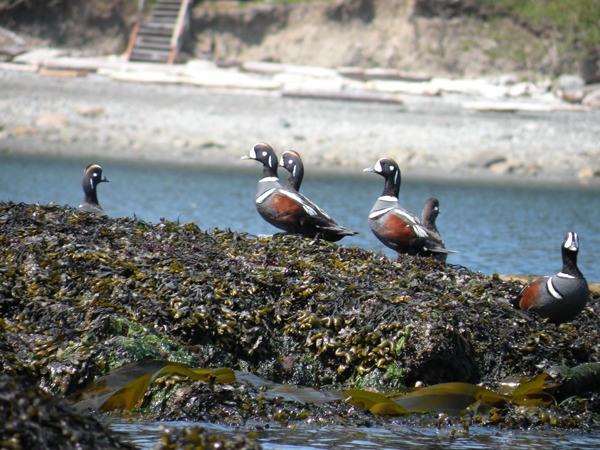By Peggy Butler
Special to the Journal
Trek to the far reaches of the continent – to the most inhospitable, jagged, rocky shorelines in freezing winter –to see a “Harley.” Or, instead, walk along our own rugged, rocky shoreline, and see why others go to such lengths. Difficult to access in other places Harlequin ducks, have extraordinarily bright, colorful and curious plumage. Lucky for us, they are common in winter along the coastline of San Juan Island. They feed in rough, frigid waters, like, say, Cattle Point Pass.
On stormy days when other sea ducks seek quieter waters, if you brave the windy bluffs along the lighthouse trail, you can see them bobbing in the white tipped waves, the boldly marked males often in single file.
Their numbers have dwindled in recent years on the East Coast and Greenland. But after nesting in either the Cascades or Olympic mountains, the same small flock of “Harleys” returns year after year to San Juan Island. Alaska and Siberia, as well as some other remote, cold, northern coastlines have appropriate habitat.
These tough ducks are small, but clutching their fine feathers close to the body, they dive into the freezing, choppy waves to crunch and eat tiny crustaceans that cling to submerged rocks. With their big webbed feet they can walk in shallow water and climb onto the very slick rocks that are hazardous to even the best water shoes—and the eager explorers wearing them. Some days you can see them congregate on the rocks below Cattle Point Lighthouse, then slipping back into the waves.
The male “Harleys,” painted deep metallic blue with orange red fenders, are stroked with what looks like white war paint in bold wide swaths across the back, neck, and head. With binoculars the bold plumage looks delightfully bizarre bobbing in the waves. “Harlequin” is a name given to a comic character in Italian culture. Wikipedia has a picture of the typical checkered costume that resembles the plumage of our duck.
Female Harleys are drab compared to the dazzling males. But they have dazzling powers. The female can, miraculously, create living Harleys – in about 30 days! The male’s beauty charms her – as it does us – but in ways other than fowl beauty (sorry). She knows that the more vivid his color, the more likely he eats well, which means he’s a strong capable diver, and that important skill will pass from his DNA to the young.
All winter the male Harlequins charm the females, showing off the fancy feathers, and enjoying the plentiful food. They will separate to mate along the wilds of mountain streams in the spring, and establish a nest together. He may bring her delicacies while she starts the fantastic art of creating new birds. But after the female has laid her magic eggs, and the nestlings hatch, the male returns to Cattle Point Pass, leaving the family behind.
While the female produced the eggs, his colorful feathers made him a fierce looking enemy to predators, and distracted enemies from the female and nest. However, with young Harleys on the loose, his colors will continue to attract predators, putting the young ones at risk. Some experts suspect that the males leave the growing family early because food is scarce along the secluded mountain streams. Like superior males of all species, he arranges matters to assist the family’s survival the best he can.
And then, alas, summer is the stroke of midnight for the drake.
Like Cinderella, he loses his beautiful costume all at once. Molting (losing feathers) leaves him mostly naked, with splotches of frayed, grayed feathers. In fact, he will look much the same as a worn out female Harlequin. So summer is “guy time” with the ladies gone, and the guys looking a little rough around the edges. Flying without feathers doesn’t work that well, either.
When our local drakes leave the nest sites to molt, they flock together at Cattle Point Pass and Third Lagoon. But when the ladies return and the mating season begins again in the fall, the stag line sharpens up with bright, colorful new plumage.
Male harlequins “present” to the ladies. Not only do they spiff up their coats, but they literally “stick their necks out” to attract the admiration of the ladies. They “present” themselves to the females by stretching their necks up in a high nod—they show off. Harlequin couples find each other year after year if they survive, but even so, the males preen and present, no slacking. The prize is just duckies!




